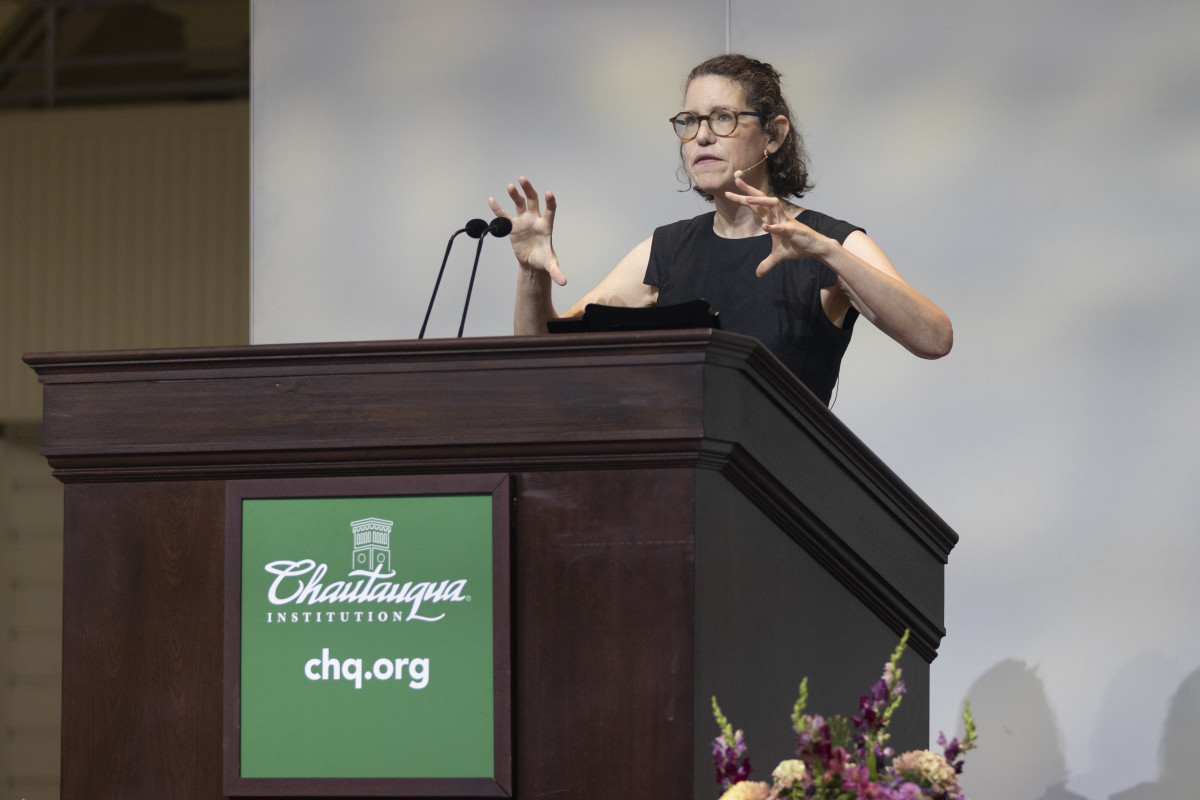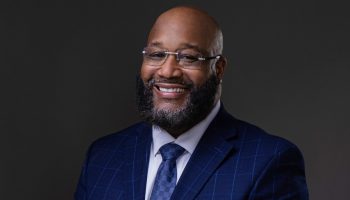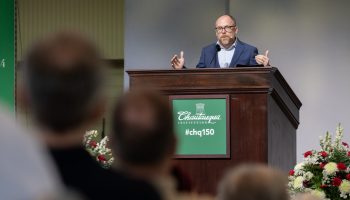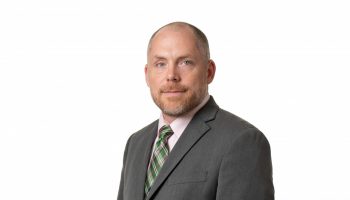As a writer, Megan McArdle spends a lot of time thinking about words. She encouraged the audience at her 10:45 a.m. lecture Monday, Aug. 8 in the Amphitheater to do the same, and specifically contemplate the word “house.” With that, she opened up Week Seven’s Chautauqua Lecture Series theme on “More than Shelter: Redefining the American Home.”
McArdle not only writes about economics, finance and government policy for The Washington Post, but she has also run her own blog since 2001, which was recently renamed “Asymmetrical Information.” In her lecture, “Homebound,” she addressed the history of housing and, ultimately, what housing allows us to do.
Although McArdle grew up on the Upper West Side in Manhattan, her idea of “house” was a little box she would draw as a kid with a triangle on top. This simple house was, of course, inhabited by a stick figure family.
“This captures so much about how we have come at housing in this country over the past half century. … The problem with our housing policy is we’re not actually dealing with a generic box house or stick figures. We’re dealing with this very, very, very complex product,” McArdle said.
Housing is essential because it impacts every aspect of our lives, she explained. From where children go to school, to where we work, to who our neighbors are — it is all impacted by housing.
“I won’t say that housing is everything, but boy, it is the lynchpin of almost everything that matters, and so, of course, this complex thing can’t be a generic commodity that’s covered by housing policy,” she said. “It’s as complicated as we are.”
Because of this, McArdle believes housing is not interchangeable with the word “home.” While housing policies might deal with the space where people actually lay their heads at night, home is about communities, and how those communities affect people’s lives.
“We talk about ‘housing’ in the abstract, but ‘home’ is in the specific. You go house hunting, but you find a home — because a home is where the people stop being stick figures and they start being individuals,” McArdle said.
To delve into this concept more fully, McArdle discussed the history of housing. For hundreds of years, the idea of a house looked the same to a lot of people because many people farmed for a living, specifically in the United States. She quoted a statistic that 72% of Americans worked in agriculture in 1820. This impacted where their house was: on or near the land they farmed.
One hundred years later, in 1920, just 30% of the workforce was in agriculture, and that again affected where people lived.
“There’s obviously a lot of cost to that. Anyone who has read Dickens is well aware,” she said. “But there’s also a lot of great things about that. We get a lot richer. We get a lot more prosperous. And then we start getting healthier.”
The Industrial Revolution initiated a widespread move to cities, which McArdle believes was only made possible by a housing revolution. During that 100-period, she said the population of New York City increased from 152,000 to 5.6 million. To make space for all these people, apartment buildings skyrocketed.
But apartment buildings were not a new invention created to deal with the 20th-century issue, McArdle explained. Ancient Rome also had apartment buildings.
“While the Romans were actually good with concrete, they were missing the two inventions you need if you really want to stack people safely and comfortably, which is structural steel and elevators — actually, really, elevator brakes,” she said. “It’s not that hard to build an elevator, but it’s hard to build an elevator that will go tall without killing you if it falls. That was the big innovation.”
The next big innovation was sanitation. The increased emphasis on sanitary measures made cities more inhabitable — and more enticing.
“Suddenly, for the first time in human history, cities are not death traps (of disease). … For the first time, you can go there safely, live comfortably with the new technologies that we have, with a ton of new people in a very small space,” she said.
These changes to make cities safe to live in were not cheap, McArdle added, but they happened because people enjoy being around other people. Cities make it possible to surround oneself with new people and new ideas.
“They’re the best places for spreading ideas. They’re phenomenally productive,” she said.
McArdle believes a reason the United States is successful is because so many people immigrated in from all over the world, bringing their cultures and ideas.
But the existence of cities relies on housing and, McArdle said, sprawl — which she acknowledges is sort of a dirty word.
The area of Manhattan where she grew up used to be known as Strycker’s Bay, long before her family lived there. It used to be a suburb, and the people would take a ferry into the city where they worked. Ferries, streetcars and trains create urban sprawl as they shorten the time it takes to get to work. McArdle pointed out that commute is an essential factor in where people decide to live.
Italian physicist Cesare Marchetti coined a concept now known as the Marchetti’s Constant, which says that people are willing to commute 30 minutes one way to go to work. McArdle views Marchetti’s Constant as key in explaining how communities are built; as commuting technologies advance and it takes less time to get to work, people move farther away from their workplaces. Increased car ownership led people to choose to live outside the city, she said.
“The old model of the suburbs was determined by the technology (like trains)that had shaped it,” she said. “… That dictated what we might call a walk-to-ride model, where you ride to a fixed destination and walk around the neighborhood. … The car doesn’t have that constraint.”
McArdle acknowledged that the racism of “white flight” contributed to suburbanization.
“We shouldn’t forget all of those harms and all of the ways in which this was bad for us and for the environment,” McArdle said.
Still, the mass movement signified people’s desires to live in suburbs.
“People weren’t just running away from the city’s problems or interracial panic; they were running to something that they wanted,” she said. “People really like single-family, detached homes with big yards where kids can play or they can sit out on a summer evening.”
Cheaper cars made it possible for the middle class, who lived in the city, to move out to the suburbs and buy detached homes in a movement McArdle called the Great Inversion.
“Historically, in cities, rich people lived close to the center because that’s where the center of the action was. Poor people ended up in a long, dismal walk away on the periphery,” she said. “In the second half of the 20th century, that pattern reverses. Suddenly, the affluent are living in a ring, and what we have in the center is people who have been left behind by the departing.”
We should not romanticize a time when people of all social classes lived together, McArdle said, because economic and racial injustices were still prevalent. Although, wealthy people living in city centers advocated for things like clean water, which positively impacted everyone living in that area.
“If you’re a billionaire on Fifth Avenue, you want the subway to work, you want crime to be low, you want your water to be clean, you want the electric utilities to be competent,” she said. “And it’s hard to have those things just for yourself.”
Twenty years ago, people started to notice that the opposite of the Great Inversion was happening. More young people who move to the cities are staying longer, delaying having children and focusing on work. But McArdle believes it started happening much sooner than the year 2000.
Housing prices rise, and McArdle said a way to combat this is to build more places for people to live — in cities, this requires building upward. However, people fight against more housing being built.
“Suburbs had long used zoning codes and other tricks to keep out ‘the undesirables.’ Cities now get into that game,” she said. “A lot of early gentrifiers were outraged to discover that when they had finally got done fixing up the place just like they liked it, some big developer would come in and want to slap up a giant apartment building so a bunch of newcomers could enjoy the hard-won amenities in this beautiful neighborhood that you had just built.”
Activists who want to conserve the communities that they and their families grew up in fight against developers coming in and building more housing. McArdle said this often doesn’t work in their favor because the lack of new development means the housing is limited, prices go up, and ultimately, rich people still move into those communities.
“In the abstract, we all favor more housing,” she said. “But in the specific, we like our home just the way it is; that is, after all, why we chose to live there. So over the last 20 years, demand just keeps going up and up, while supply is going much more slowly. And that’s the housing crisis.”
Housing issues also exist in small towns and their communities. Often, McArdle said, the message to people who live in small towns is to move somewhere they can get a more lucrative job.
“If you don’t have a lot of money,” she said, “you tend to substitute social capital for financial capital.”
This means that people in small towns rely on family members to watch their children or call up a friend to fix their plumbing, rather than paying someone they don’t know, McArdle explained. When you live like this, it builds community, and that makes it even harder to leave.
“I love cities,” McArdle said. “I’ve lived in a city all my life. I’m not really sure I can live anywhere else. But there are a lot of people who don’t feel like me, and the only advice that we could give them was, ‘Be more like me.’ ”
Often, moving to a city doesn’t solve a person’s financial problems. For example, in California, teachers make double what teachers in Mississippi make, but in California, the cost of living is more expensive in terms of housing, groceries and taxes. It is, therefore, not always a smart financial decision to move somewhere just because the salary is higher.
“I’ve been talking in the present tense, even though I’m not really talking about the present. I’m talking about the economy as it looked on March 7, 2020,” she said.
McArdle believes the pandemic might have shown the United States a different method to approach the housing crisis.
“The pandemic has shown us a way around the bottlenecks we’ve created by refusing to build in the biggest cities,” she said.
A large answer to being able to live where we want and work where we want might come down to working remotely, which is made possible by platforms like Zoom.
“We should think of Zoom … as a technological transformation that eases the Marchetti Constant. In some cases, it blows it up,” she said. “Imagine a world where you can commute to anywhere in the world in 30 seconds. That’s exciting, right? It opens up so much land we could build on. And we could, if we could get our regulatory act together.”
Zoom can make new communities possible, she said. As of right now, building houses is expensive, but McArdle thinks we need to reimagine that. Instead of bringing all the materials to the site and building there, people should look more into modular homes. McArdle pointed to how some start-ups are even 3D printing homes.
“If we could make it work, we could be looking at some of the most exciting changes to American communities in decades, if not centuries,” she said. “We could make it easier for people to move out to the country. We could make it easier for people to move back to cities like Buffalo, which has a ton of lovely old houses and an amazing history — and a convenient location near some of the most beautiful scenery on Earth.”
She described it as reversing the vacuum. Instead of cities sucking in people and resources, people can spread back out and cover more land because they can work remotely.
“I’ve spoken to so many people, from Rochester and Syracuse and Buffalo and the towns around them, who wanted nothing more than to be here spending six months of every year scraping the snow off their windshield, but they couldn’t,” she said. “They had to leave home and everything they loved because they’d get a better job in the city or better house in the Sun Belt.”
While it might be a dream for some to live anywhere and work remotely, McArdle thinks the future of work looks more like a hybrid model, with people commuting in only a couple days a week rather than five.
“So now the Marchetti Constant — don’t think of it on a daily basis, but on a weekly basis,” she said.
This would mean people might be more willing to commute for longer, if they do not have to commute as frequently. McArdle thinks this would create more of a sprawl, which could help housing prices.
She knows, however, that not everyone can choose to work remotely. Some jobs cannot be done over Zoom. For those, they need affordable housing, which McArdle said can happen by building more houses — or reworking office spaces left empty by the COVID-19 pandemic into housing options.
McArdle also considers what people will do with their ability to work remotely.
“To be fair, there’s nothing wrong with wanting to drink coffee while looking at beautiful scenery. I have been doing it for two days, and I am so grateful,” she said. “But I think if that’s all remote work does, is enable highly-paid professionals to enjoy themselves even more, while displacing locals, I think we’ve failed. We can do better than that. This is America. We can still do big things.”
McArdle circled back to the idea of home. When she thinks of home, she thinks of the Victorian chair that her mother used to rock and sing to her in before she went to bed. That chair now sits in the home McArdle shares with her husband and her dogs.
“I’m actually really asking you to look back on your own reflections about home,” she said. “When you were thinking about home, were you really thinking about a house, or were you thinking about the people who were in it? Were you thinking about the people who made that the place (where) you will always be safe and warm and at peace?”
When people think of the housing crisis, McArdle they often only think of the technical side: the physical space.
“Everyone needs someplace to keep the rain off of their heads, and we need to figure out how to give it to them. But we need to do so much more than that, because, in the end, we need a house,” she said. “But we are still, all of us, wanting something that’s so much more important. We are longing for home.”





